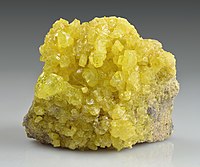
Photo from wikipedia
Abstract The first technical developments on thermochemical cycles for hydrogen production are based on the use of sulphur as a redox material. After the oil crises of the 1970s, high… Click to show full abstract
Abstract The first technical developments on thermochemical cycles for hydrogen production are based on the use of sulphur as a redox material. After the oil crises of the 1970s, high temperature (over 1200 K) heat from nuclear very high temperature reactors (VHTRs) was considered as a promising energy vector to produce fuels for the transport sector. The chemical reactions to convert water into hydrogen must fit to this heat source. As metal-oxide based cycles need higher temperature levels they were not taken into account at that time. The development of the sulphur cycles lost momentum during the 1980s because of cheap fossil fuels. But in the beginning of the 2000s they came back into the focus with the intention to reduce CO 2 emissions. At that time their coupling to heat from concentrated solar radiation in large scale was developed. The interest from the nuclear energy side faded again when the interest in VHTRs lost momentum. In parallel concentrated solar technologies were not implemented fast enough. The developments were mainly achieved by research institutions that concentrated more on the metal-oxide technologies. However, sulphur based cycles remain very promising because the necessary temperature is low compared to metal-oxide cycles and sulphur and sulphuric acid are amongst the most important chemical products offering a high potential of synergies with other processes. The present analysis gives an overview on recent developments and the state-of-the-art of this type of cycles, has a look on the most important performance parameters involved, and gives an outlook on further potential and necessary developments.
Journal Title: Solar Energy
Year Published: 2017
Link to full text (if available)
Share on Social Media: Sign Up to like & get
recommendations!